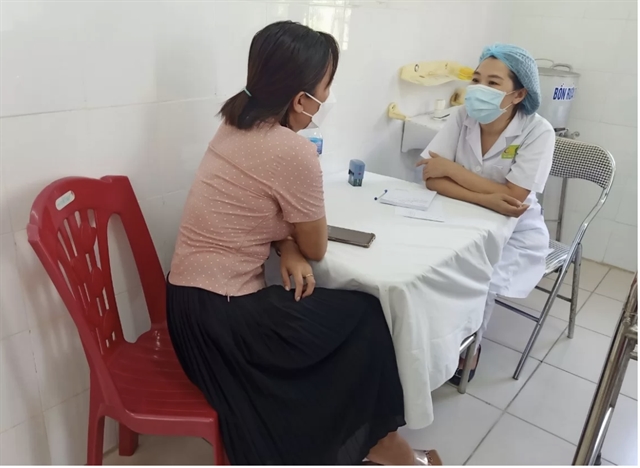 Society
Society

 |
| A woman is getting consultancy on cervical cancer. — Photo baoquangninh.vn |
HÀ NỘI — Cost of cervical cancer screening should be considered for coverage by health insurance to help reduce the financial burden on women and their families, said experts.
The Vietnam Women's Union coordinated with the Social Committee of the National Assembly and the Ministry of Health organised a workshop on Tuesday to propose a policy to include the cost of cervical cancer screening in the list of health insurance coverage.
Cervical cancer is an issue of concern for public health because this disease greatly affects the welfare, health and spiritual life of women and the entire population, Tôn Ngọc Hạnh, deputy chairwoman of the Việt Nam Women's Union, said in the meeting.
Without any intervention, it is estimated that about 200,000 Vietnamese women will die from cervical cancer by 2070, she said.
Cervical cancer treatment is very expensive, but the disease can be completely prevented or eliminated based on HPV (human papillomavirus) vaccination and regular screening to detect and treat pre-cancerous signs early.
However, in Việt Nam, the rate of access to cervical cancer prevention and screening measures among Vietnamese women is still low, she said.
According to Việt Nam’s Ministry of Health and UNFPA research in 2021, only 12 per cent of women and girls aged 15-29 were vaccinated against HPV and only 28 per cent of women aged 30-49 were screened, very low rates.
One of the reasons leading to the low rate of access to cervical cancer prevention and screening measures is that the cost of HPV vaccine is very high and it is not included in the expanded vaccination programme, and cervical cancer screening is not covered by health insurance.
Hạnh said: “Increasing women's access to screening, examination, and early diagnosis of cervical cancer services is necessary, in accordance with the policy of people's health care to meet the principle of “disease prevention is better than treatment”, as well as helping reduce the financial burden on women and their families and decreasing social costs from cervical cancer treatment.”
“This is also consistent with Việt Nam's international commitments in implementing the United Nations Sustainable Development Goals (SDGs),” Hạnh said.
According to the World Health Organisation's assessment, eliminating cervical cancer will contribute to the implementation of SDG1 on multi-dimensional poverty, SDG3 on healthy lives, SDG5 on gender equality and SDG10 on reducing inequality.
The global strategy to eliminate cervical cancer announced by the World Health Organisation in 2020 has set a target that countries need to achieve by 2030 to eliminate cervical cancer with 90 per cent of girls fully vaccinated against HPV before age 15; 70 per cent of women receiving highly accurate screening tests at ages 35 and 45; and 90 per cent of women who are identified as having pre-cancerous and cancerous lesions receiving care and treatment.
According to the Department of Maternal and Child Health under the Ministry of Health, cervical cancer is one of the leading causes of death in women. Every year in the world, there are about 604,000 new cases and 342,000 women die from this disease. HPV infection is the main cause of cervical cancer.
Preventing cervical cancer plays an indispensable role in achieving sustainable development goals.
In Việt Nam, cervical cancer is the 4th most common cancer in women and the 2nd most common cancer in women of reproductive age, after breast cancer.
The standard incidence rate by age is about 8.1 per 100,000 women. Each year there are over 400 new cases and over 2,000 deaths from cervical cancer.
Cervical cancer screening methods in Việt Nam include VIA (naked eye observation with acetic acid) that has sensitivity of 40-70 per cent and specificity of 88-95 per cent and tested every three years; cervical cell test (Pap smear) - sensitivity of 50-55 per cent, specificity of 96.8 per cent and performed every three years; and HPV test with sensitivity of 94.6 per cent, specificity of 94.1 per cent and performed every five years.
Thus, HPV testing is one of the effective and long-term valuable disease screening and prevention measures.
The goal of the National Action Plan by 2025 is to have 25 per cent of girls vaccinated against HPV by age 15; 60 per cent of women getting screened with highly effective methods at age 35 and rescreened at age 45; 90 per cent of women with pre-cancer or invasive cancer getting treatment.
The department affirms that cervical cancer is not only an obstetric and gynaecological disease, but also a public health and primary health issue. The participation of authorities and international partners, the health sector, school health systems, the Women's Union, families and individual women are needed.
It is necessary to mobilise resources from sectors and agencies, aiming to include the cost of cervical cancer screening in the expanded vaccination programme and health insurance.
Phan Văn Toàn, deputy director of the Health Insurance Department, Ministry of Health, said that the number of people participating in health insurance by December 31, 2023 is over 91.07 million people, reaching 92.04 per cent of the population.
The health insurance fund ensures balance of revenue and expenditure and has a surplus, Toàn said.
In the draft revised Law on Health Insurance, people with health insurance will have medical examination and treatment costs covered by the health insurance funds, including rehabilitation, regular prenatal check-ups, childbirth, medical examination to assess the risk of certain diseases such as cervical cancer, breast cancer, hypertension, diabetes, hepatitis B and C; prenatal and newborn screening, preventive treatment, and periodic health checks for children under six years old and pensioners, he said. — VNS